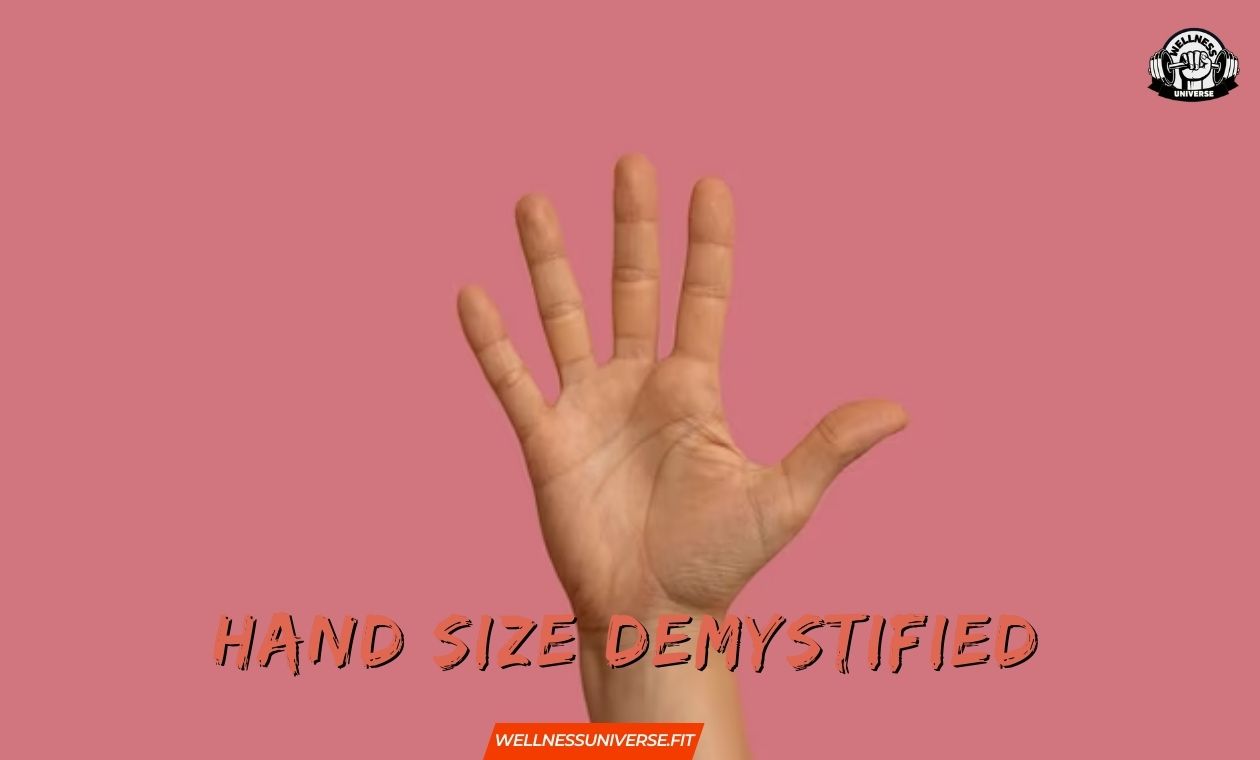Hand size refers to the physical dimensions and proportions of an individual’s hands, including the length, width, and thickness of the palm, fingers, and thumb. It is a unique characteristic that varies among individuals and can have an impact on various aspects of life, including athletics, fine motor skills, and overall functionality.
The size of the hands plays a significant role in many activities, from simple daily tasks to professional pursuits. It affects our ability to grip objects, manipulate tools, and perform delicate tasks requiring dexterity. Hand size can also have implications in sports, where grip strength and hand-eye coordination are essential for optimal performance. Additionally, hand size can influence musical proficiency, as certain instruments require specific hand dimensions and finger reach.
Understanding hand size and its implications is valuable for several reasons. Firstly, it helps individuals gain insight into their own physical attributes and how they may impact their abilities in various areas of life. By recognizing the relationship between hand size and different activities, individuals can make more informed choices and pursue activities that align with their natural strengths.
Furthermore, understanding hand size can aid in personal development and goal setting. It allows individuals to identify areas where they may have inherent advantages or challenges, enabling them to focus their efforts on areas where they have a higher likelihood of success. This knowledge can also help individuals overcome potential obstacles and find strategies to maximize their performance or enhance specific skills related to hand usage.
By delving into the factors that contribute to hand size and exploring its implications, individuals can gain a deeper appreciation for the uniqueness of human anatomy and the diverse abilities it affords. Additionally, understanding hand size can foster inclusivity and appreciation for the variations among individuals, promoting a more inclusive and accepting society.
By the end, you will have a comprehensive understanding of hand size and its impact on human capabilities.
Does Hand Size Determine Athletic Ability?

Hand size has long been a topic of interest when discussing athletic ability. While hand size alone does not solely determine an individual’s athletic prowess, it can play a role in certain aspects of performance. The size and proportions of the hands can affect grip strength, hand-eye coordination, and ball control, which are crucial in many sports.
- Basketball: In basketball, hand size can influence a player’s ability to grip and control the ball. Players with larger hands may find it easier to palm the basketball, providing them with an advantage in ball handling, passing, and shooting. Additionally, a larger hand surface area can help with rebounding and defending by providing a wider coverage area.
- Baseball and Softball: In throwing and catching sports like baseball and softball, hand size can affect the ability to grip and control the ball. Pitchers with larger hands may have an easier time manipulating the ball, allowing for better control and varied pitches. Similarly, fielders with larger hands may have an advantage in catching and securing the ball.
- Tennis and Racquet Sports: Hand size can impact grip strength and control in tennis and other racquet sports. A larger hand may allow for a more secure grip on the racquet, enhancing power and precision in shots. It can also help generate spin and control the ball during serves and volleys.
- Climbing: In rock climbing, hand size and finger length can influence an individual’s ability to grip and hold onto small handholds and rock edges. Climbers with smaller hands may find it easier to grip smaller holds, while those with larger hands might excel in gripping larger holds.
While hand size can have an impact on certain aspects of athletic performance, it is essential to note that it is just one of many factors that contribute to overall athletic ability. Other factors such as body composition, muscle strength and endurance, agility, coordination, and cardiovascular fitness also play significant roles in determining athletic performance.
Additionally, skills, techniques, training, and experience are vital aspects of athletic ability that can outweigh the influence of hand size alone. For example, a tennis player with smaller hands but excellent footwork, timing, and stroke mechanics can still achieve a high level of play.
It is important to recognize that athletic ability is a complex interplay of various factors, and no single factor, such as hand size, can solely determine an individual’s athletic success. Each sport has its unique demands and requirements, and athletes with different hand sizes can excel with the right combination of skills, training, and dedication.
Factors Contributing to Hand Size
Hand size, like many other physical traits, is influenced by genetic factors. The size and shape of our hands are determined by the interplay of various genes inherited from our parents. These genes control the growth and development of bones, muscles, and other tissues in the hands. While genetics play a significant role, it is important to note that hand size can still vary among individuals within the same family.
Hormones also play a role in hand development and can contribute to differences in hand size between males and females. During puberty, hormonal changes, particularly the increased levels of testosterone in males, can lead to growth spurts and the development of larger hands. This hormonal influence on hand growth is why, on average, men tend to have larger hands than women. However, it is essential to remember that there is a wide range of hand sizes within both genders, and individual variation exists.
While genetics and hormones have a significant impact on hand size, environmental and lifestyle factors can also influence hand development to some extent. Here are a few factors that may contribute to hand size:
- Nutrition: Adequate nutrition during childhood and adolescence is crucial for proper growth and development, including hand size. A balanced diet that provides essential nutrients like protein, vitamins, and minerals can support optimal bone and muscle development, potentially contributing to the overall size and strength of the hands.
- Physical activity: Engaging in regular physical activity, particularly activities that involve hand usage, can promote the development of hand muscles and potentially affect hand size. Certain sports or occupations that require frequent hand use and grip strength may contribute to the development of larger and stronger hands.
- Injury or trauma: Injuries or trauma to the hands, especially during growth and development stages, can affect hand size. Fractures, dislocations, or other injuries that involve the growth plates or bones in the hands can disrupt normal growth and potentially lead to variations in hand size.
- Medical conditions: Certain medical conditions, such as acromegaly (a hormonal disorder causing excessive growth), may result in larger-than-average hands. Conversely, conditions that affect growth, such as hormonal deficiencies or genetic disorders, may contribute to smaller hand size.
It is important to note that while these environmental and lifestyle factors can influence hand development to some extent, their impact may be relatively minor compared to genetic and hormonal factors.
Understanding the various factors that contribute to hand size can help provide insight into the diversity of hand sizes among individuals. It is essential to embrace and appreciate our unique hand sizes, recognizing that they are the result of a complex interplay of genetic, hormonal, and environmental factors.
Hand Size and Grip Strength
Hand size has a significant impact on grip strength, although it is not the sole determining factor. The size and structure of the hand, including finger length, palm width, and hand thickness, can influence the ability to generate and maintain a strong grip. Larger hands often provide a larger surface area and more leverage, allowing for a potentially stronger grip. However, it is important to note that individuals with smaller hands can still develop impressive grip strength through training and specific exercises.
- Weightlifting: Hand size can affect performance in weightlifting exercises that require a strong grip, such as deadlifts, pull-ups, and farmer’s walks. Individuals with larger hands may find it easier to grip and control heavy weights due to the increased surface area and leverage. However, individuals with smaller hands can still improve their grip strength and technique to excel in these exercises.
- Sports: Hand size can also influence performance in sports that require gripping, throwing, or catching, such as basketball, baseball, tennis, and rock climbing. In sports like basketball, a larger hand size can provide an advantage in ball handling and grip control. Similarly, in baseball and tennis, a larger hand can aid in gripping the ball or racket, enhancing accuracy and power. However, individuals with smaller hands can still excel in these sports through technique, agility, and other physical attributes.
- Everyday activities: Hand size can impact various everyday tasks that rely on grip strength, such as opening jars, carrying heavy objects, or gripping tools. Larger hands may provide more stability and control in these activities, but individuals with smaller hands can adapt and develop grip strength to effectively perform these tasks.
Regardless of hand size, it is possible to improve grip strength through targeted exercises and training techniques. Here are some strategies to enhance grip strength:
- Hand and forearm exercises: Incorporate exercises that specifically target the muscles of the hands and forearms, such as grip squeezes, wrist curls, and finger extensions. These exercises can strengthen the muscles involved in grip and contribute to improved grip strength.
- Grip training tools: Utilize grip training tools like hand grippers, grip balls, and grip trainers. These tools provide resistance and allow for progressive overload, helping to develop grip strength and endurance.
- Farmer’s walks and carrying exercises: Perform exercises like farmer’s walks, suitcase carries, or sandbag carries. These exercises challenge grip strength while simulating real-life activities that require grip stability and control.
- Barbell and dumbbell exercises: Engage in barbell and dumbbell exercises that require a strong grip, such as deadlifts, rows, and pull-ups. Focus on maintaining a secure grip throughout the movements, gradually increasing weights to progressively overload the grip.
- Active lifestyle: Engage in activities that naturally promote grip strength development, such as rock climbing, gymnastics, or martial arts. These activities challenge the grip in dynamic and functional ways, leading to improved grip strength over time.
It is important to note that while hand size can influence grip strength to some extent, the key to improving grip strength lies in consistent training, proper technique, and progressive overload. By implementing these strategies, individuals of all hand sizes can enhance their grip strength and performance in various activities.
Natural Ways to Improve Hand Size
It is important to note that hand size is primarily determined by genetic factors and bone structure, and it is not possible to significantly alter the size of your hands naturally. While there are certain techniques and exercises that can improve hand health, flexibility, and strength, they will not lead to a substantial increase in hand size. It is essential to have realistic expectations and focus on optimizing the function and performance of your hands rather than attempting to alter their size.
- Maintain proper hand hygiene: Regularly washing your hands with mild soap and water helps keep them clean and prevents the buildup of bacteria that could potentially lead to infections or skin issues. Additionally, moisturizing your hands can prevent dryness and cracking, promoting overall hand health.
- Stretching exercises: Engaging in regular stretching exercises can enhance hand flexibility and range of motion. Simple exercises like finger stretches, wrist circles, and hand opening and closing can help loosen the muscles, tendons, and ligaments in the hands, improving dexterity and reducing the risk of injuries.
- Warm-up and cooldown routines: Prior to engaging in activities that require hand use, such as sports or weightlifting, it is important to perform warm-up exercises. These exercises can include gentle finger and wrist movements, shaking out the hands, and massaging the muscles. Cooling down after activities with gentle stretches can help relax the muscles and promote recovery.
- Hand massages: Massaging the hands regularly can increase blood circulation, relax the muscles, and relieve tension. Use your opposite hand to apply gentle pressure and knead the muscles in your palm, fingers, and thumb. You can also use a tennis ball or massage ball to roll and apply pressure to the muscles in your hand.
- Hand grip exercises: Grip strength exercises can improve the strength and endurance of the muscles in your hands. Squeeze a stress ball, hand gripper, or tennis ball for a few seconds and release. Repeat this exercise for several repetitions to work the muscles responsible for gripping.
- Finger exercises: Strengthening the muscles in your fingers can enhance hand performance. Practice finger extensions by placing a rubber band around your fingers and opening them against the resistance of the band. You can also press your fingertips against a solid surface, like a table, and lift each finger individually.
- Hand and finger resistance exercises: Utilize resistance bands or rubber bands to provide resistance during hand and finger exercises. Wrap a band around your fingers and thumb, then open your hand against the resistance. This exercise targets the muscles responsible for finger abduction and can improve hand strength.
- Hand dexterity exercises: Engage in activities that promote hand dexterity and coordination, such as playing a musical instrument, solving puzzles, or practicing fine motor skills. These activities challenge the muscles in your hands and fingers, improving their control and precision.
Remember to start slowly and gradually increase the intensity and duration of these exercises over time. It is important to listen to your body and stop any exercise that causes pain or discomfort. By incorporating these exercises into your routine, you can enhance hand health, flexibility, and strength, maximizing your hand’s performance and functionality.
In Crux
In conclusion, hand size is a unique and inherent characteristic that varies from person to person. While hand size may have certain implications in specific areas such as athletics, grip strength, and musical instrument proficiency, it is crucial to remember that individual strengths and abilities extend far beyond hand size alone.
Every person possesses unique talents, skills, and qualities that contribute to their overall abilities and accomplishments. Hand size should not be a sole determining factor of one’s capabilities or self-worth. Instead, it is important to focus on optimizing and leveraging the strengths and abilities that one does possess, regardless of hand size.
Rather than becoming fixated on altering or changing hand size, it is more beneficial to embrace and optimize the hand size one has been naturally given. By maintaining hand health, flexibility, and strength, individuals can enhance their hand’s performance and functionality, enabling them to engage in various activities with confidence and skill.
Remember that hand size is just one piece of the puzzle. Developing grip strength, dexterity, and fine motor skills can greatly contribute to overall hand performance. By practicing regular exercises and activities that promote hand health and strength, individuals can maximize their hand’s potential regardless of its size.
Ultimately, the key is to focus on personal growth, continuous improvement, and self-acceptance. Celebrate the unique qualities and abilities that make you who you are. By embracing your hand size and working towards optimizing your hand’s capabilities, you can achieve great things in various aspects of life.
So, whether you have large hands, small hands, or hands of any size in between, remember that your worth and potential extend far beyond your physical attributes. Embrace your hand size as a part of your individuality and use it as a catalyst to explore and develop your talents and passions.
In the end, it is not the size of your hands that matters most, but rather how you use them to create, accomplish, and make a positive impact in your own life and the lives of others.
Thank you for joining us on this fitness journey! We hope you found our Hand Size Demystified: Beyond Measurements and into Abilities blog insightful and inspiring. Our aim is to provide you with valuable information, expert advice, and motivational content to support you in your wellness endeavors.
Related Post :-
- How To Do Wall Pushups
- Batman Workout
- CrossFit Unleashed
- Barbell Lunges
- Forearm Fortitude
- Kettlebell Circuit
FAQs about Hand Size
Can hand size change over time?
Hand size is primarily determined by genetics and does not significantly change over time. However, hand strength, flexibility, and coordination can improve with regular exercise and targeted training.
Are there any advantages or disadvantages to having larger hands?
Larger hands may provide advantages in activities that require grip strength, such as rock climbing or weightlifting. On the other hand, smaller hands may be advantageous in tasks that demand intricate finger movements, such as playing musical instruments or typing on a keyboard.
Can hand size affect performance in specific sports?
Hand size can influence performance in certain sports. For example, athletes with larger hands may have an advantage in basketball for better ball control and grip, while smaller hands can be advantageous in sports like gymnastics where precision and grip strength are crucial.
Is there a correlation between hand size and height?
There is a general correlation between hand size and height, but it is not absolute. While taller individuals tend to have larger hands on average, individual variations exist, and hand size alone cannot accurately determine a person's height.
How does hand size relate to glove sizing?
Hand size plays a key role in determining the appropriate glove size. Manufacturers typically provide size charts based on hand measurements to ensure a proper fit, considering factors such as hand width, finger length, and circumference.
Does hand size impact musical instrument proficiency?
Hand size can affect musical instrument proficiency to some extent. Individuals with larger hands may find it easier to reach wider spans on instruments like pianos or guitars, while those with smaller hands may excel in instruments requiring more precise finger movements, such as violins or flutes.
Is hand size genetically determined?
Yes, hand size is largely determined by genetics. It is influenced by factors like bone structure, finger length ratios, and overall body proportions. However, environmental factors and lifestyle choices can also influence the development of hand muscles and flexibility.
Can hand size affect grip strength?
Hand size can impact grip strength to a certain degree. Individuals with larger hands may have a larger surface area to generate grip strength, while individuals with smaller hands can still develop strong grips through proper training and hand strengthening exercises.
What factors contribute to hand size?
Hand size is influenced by various factors, including genetics, hormone levels, and overall body proportions. Hormones such as testosterone play a role in hand development during puberty, affecting bone growth and muscle mass in the hands.

Meet Pradeep Singh, your go-to guide for all things fitness, health, and motivation. With over 7 years in the field, Pradeep brings a blend of expertise and real-world experience to his writing. From workout tips to healthy living insights, he simplifies complex topics, making fitness accessible for everyone. His authentic approach and genuine passion aim to inspire and support your wellness journey. Get ready to embark on a path to a healthier lifestyle with Pradeep as your trusted companion and motivator.






















